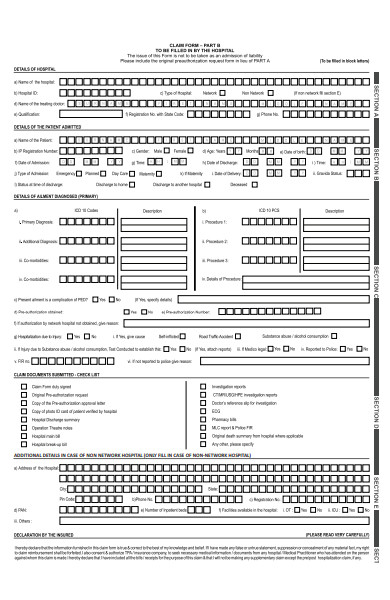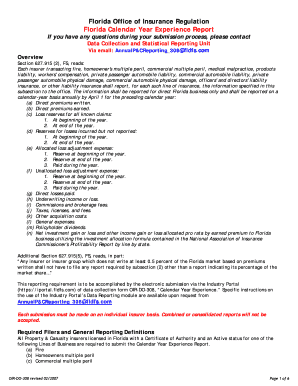Office Of Insurance Regulation Form
Post Title: A Comprehensive Guide to Filing Insurance Claims with the Office of Insurance Regulation (OIR) Introduction: Are you facing the aftermath of a catastrophic event? It's essential to navigate through the insurance claims process with ease and efficiency. The Office of Insurance Regulation (OIR) understands the challenges policyholders may encounter during these distressing times. In this guide, we will provide you with a step-by-step overview of how to file an insurance claim using the OIR's official form. We'll walk you through the process, from accessing the form to submitting it, ensuring you have all the necessary information for a smooth claims experience. Subheading 1: Understanding the Office of Insurance Regulation (OIR) The Office of Insurance Regulation (OIR) is a regulatory agency in Florida responsible for overseeing and ensuring fair practices in the insurance industry. Their primary goal is to protect and educate policyholders, working towards a transparent and efficient insurance market in the state. Subheading 2: Accessing the OIR Form FL OIR-B1-1571 To initiate the claims process, you'll need to access Form FL OIR-B1-1571 provided by the Office of Insurance Regulation. This form serves as a standardized document for reporting insurance claims in the state of Florida. Follow these steps to obtain the form: 1. Visit the OIR's official website: Start by visiting the official website of the Office of Insurance Regulation. A quick search on your preferred search engine will lead you to their homepage. 2. Navigate to the Forms section: Once you're on the OIR's website, locate the Forms section. It is usually found in the main menu or under a dedicated tab for resources. 3. Search for FL OIR-B1-1571: Within the Forms section, search for Form FL OIR-B1-1571. This form is specifically designed for reporting insurance claims related to catastrophic events. 4. Download or Fill Online: You have two options for completing the form. You can either download the PDF version of the form and fill it out manually, or use the available online fillable version. Choose the option that suits your preferences and convenience. Subheading 3: Steps for Completing the OIR Form FL OIR-B1-1571 Once you have the OIR form in your possession, it's time to start filling it out. Follow these steps to ensure a complete and accurate submission: 1. Provide Identification Information: Start by entering your personal details, including your name, address, phone number, and email address. This information is crucial for the insurance company to contact you regarding your claim. 2. Describe the Catastrophic Event: Explain the nature and extent of the catastrophic event that caused the damage or loss. Be precise and provide as much detail as possible. Use the "A. Nature of Catastrophe" section to paint a clear picture of the event. 3. Include the Insurance Company Information: Enter the name and contact details of your insurance company. This helps in ensuring that your claim is routed to the correct department within the company. 4. Upload Supporting Documentation: Attach any supporting documentation that can substantiate your claim. This may include photographs of the damage, repair estimates, police reports, or any other relevant evidence. Make sure the documentation is clear and legible. 5. Sign and Date the Form: Before submitting the form, be sure to sign and date it. This verifies the authenticity of the information provided and allows the insurance company to process your claim accordingly. Subheading 4: Frequently Asked Questions (FAQs) about OIR Form FL OIR-B1-1571 Q1: Can I submit the OIR form electronically? A1: Yes, the OIR provides an online fillable version of the form, allowing you to complete it electronically. However, you may still choose to print and mail the completed form if it's more convenient for you. Q2: How long does it take for a claim to be processed? A2: The processing time for insurance claims varies depending on several factors, including the complexity of the claim and the responsiveness of the insurance company. It's advisable to follow up with your insurer regularly to stay informed about the progress of your claim. Q3: What should I do if my claim is denied? A3: If your claim is denied by the insurance company, you have the right to appeal the decision. Consult with an attorney specializing in insurance claims to explore your options and understand the steps involved in the appeals process. Conclusion: Filing an insurance claim can feel overwhelming, but with the guidance provided through the Office of Insurance Regulation's Form FL OIR-B1-1571, you can navigate the process with confidence. Remember to accurately fill out the form, provide thorough documentation, and maintain open communication with your insurance company. By following these steps, you'll maximize your chances of a successful claim resolution. Stay informed, be proactive, and assert your rights as a policyholder – the Office of Insurance Regulation is here to assist you every step of the way. Disclaimer: This post is provided as a guide and should not substitute professional advice. Each insurance claim may have unique requirements, and it's advisable to consult with an attorney or insurance expert for personalized assistance. The data used in this post is for illustrative purposes only and does not represent an endorsement by the Office of Insurance Regulation or any specific entity.  Image Source : news.wfsu.org
Image Source : news.wfsu.org  Image Source : www.pdffiller.com
Image Source : www.pdffiller.com  Image Source : capitalsoup.com
Image Source : capitalsoup.com  Image Source : www.pdffiller.com
Image Source : www.pdffiller.com  Image Source : www.pdffiller.com
Image Source : www.pdffiller.com  Image Source : www.sampleforms.com
Image Source : www.sampleforms.com  Image Source : choices.fldfs.com
Image Source : choices.fldfs.com  Image Source : www.pdffiller.com
Image Source : www.pdffiller.com
2016 Florida Healthcare Rates Raise A Question: Where Did The PPOs Go
florida rates did insurance prices information raise healthcare ppos question where go wfsu ppo compliant aca regulation released rate plans
2004-2022 Form FL OIR-B1-1571 Fill Online, Printable, Fillable, Blank
 Image Source : www.pdffiller.com
Image Source : www.pdffiller.com form disclosure standard acknowledgement 2021 2004 pdffiller sign injury protection personal signnow
DATA CALL NOTICE: Hurricane Nicole Catastrophe Reporting
 Image Source : capitalsoup.com
Image Source : capitalsoup.com 2003 Form FL OIR-B1-1571 Fill Online, Printable, Fillable, Blank
 Image Source : www.pdffiller.com
Image Source : www.pdffiller.com disclosure oir pdffiller 1571 acknowledgement
Questionnaire On Umbrella - Fill Online, Printable, Fillable, Blank
 Image Source : www.pdffiller.com
Image Source : www.pdffiller.com insurance umbrella questionnaire regulation amp office life pdffiller form
FREE 25+ Insurance Forms In PDF | MS Word
 Image Source : www.sampleforms.com
Image Source : www.sampleforms.com CHOICES: Homeowners Rate Comparison Tool
 Image Source : choices.fldfs.com
Image Source : choices.fldfs.com choices homeowners
Fillable Online Florida Office Of Insurance Regulation Florida Calendar
 Image Source : www.pdffiller.com
Image Source : www.pdffiller.com Free 25+ insurance forms in pdf. Questionnaire on umbrella. Fillable online florida office of insurance regulation florida calendar. 2016 florida healthcare rates raise a question: where did the ppos go. Choices: homeowners rate comparison tool